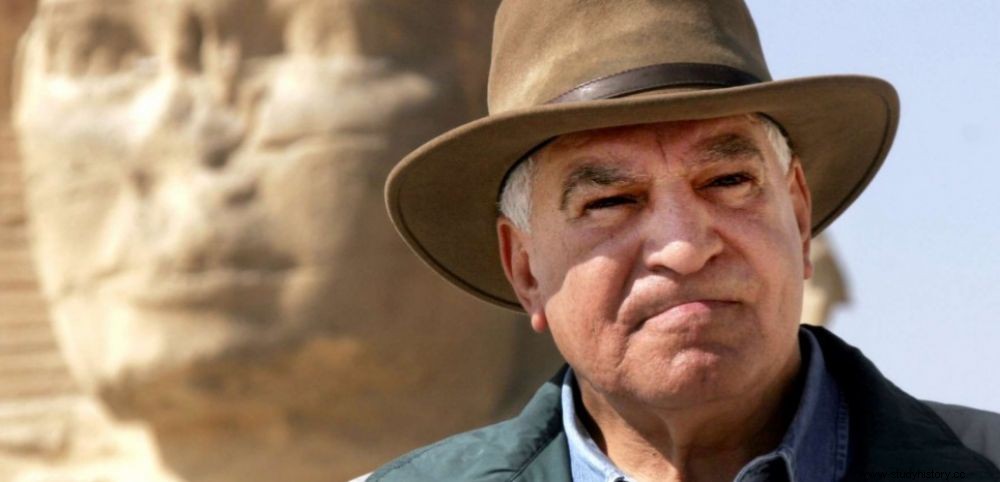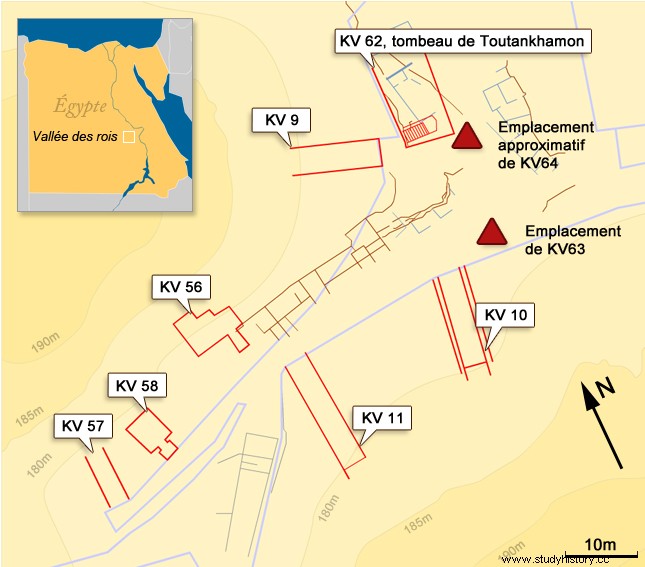 Zahi Hawass, Egypt's former Minister of Antiquities, in front of the Sphynx on the Giza Plateau.
Zahi Hawass, Egypt's former Minister of Antiquities, in front of the Sphynx on the Giza Plateau. CONTROLLING. Full attack in the Valley of the Kings! Even if he is no longer Minister of Egyptian Antiquities (since 2011), nor even Secretary General of the Supreme Council of Egyptian Antiquities, positions he held from 2002 to 2010, the very influential Dr. Zahi Hawass continues to give the tone regarding archaeological discoveries in Egypt. The stainless man in the stetson and the blue shirt, who received in front of the Sphinx, in Giza, the greats of this world, has lost none of his verve. And this time, it's the cannon that he fires. In a virulent article published Monday, November 9, 2015 in the daily Egypt Independent Zahi Hawass publicly attacks Nicholas Reeves, the British archaeologist, director of the royal tombs project of Amarna*, in Middle Egypt, at the origin of the hypothesis according to which the tomb of the great queen Nefertiti could be find in an unknown chamber hidden in Tutankhamun's tomb.
"I couldn't believe my ears when I heard Antiquities Minister Mamdouh Eldamaty say on TV that Nicholas Reeves [..] used to work in the Valley of the Kings, where he allegedly discovered tomb no. 63 [read below Editor's note]. Which I refute for not allowing someone of Reeves' ilk to claim false archaeological finds and seek glory at the expense of our history!" But why so much anger on the part of the man who today travels the five continents giving sold-out conferences in an attempt to bring tourists back to Egypt? The animosity between the two men is not new.

The red triangles designate the cavities spotted using radar by Nicholas Reeves' team in the early 2000s. © Damien Hypolite d' after ARTP Project Valley of the Kings. S.Nishiyama Compilation.
In February 2006, the discovery in the Theban necropolis of the tomb KV 63 (for "King Valley 63"), the first to be found since that of Pharaoh Tutankhamen (KV 62) in 1922, had inflamed all hopes (see map of the tombs above), starting with those of Otto J. Schaden ( University of Memphis, United States) at the origin of the find. But only a few wooden sarcophagi and large jars were exhumed. No great royal treasures! However, what had probably been only a cache or an embalming chamber in antiquity had already been located in the year 2000, by radar, by Nicholas Reeves' team.
Antiquities Misappropriation Accusations
Other radar images had above all reported the presence of an intriguing second cavity (KV64) near the burial of Tutankhamun... hence perhaps the origin of this current hypothesis defended by Nicholas Reeves, reinforced by photographic surveys in high definition of Factum Arte, of a possible presence of the tomb of Nefertiti in this sector. Why did the British Egyptologist have to wait until 2006 to reveal this data? It is that in the meantime, his archaeological mission had known… disgrace! In 2002, his excavation permit had indeed been revoked for three years by Zahi Hawass and the Egyptian authorities, following accusations of misappropriation of antiquities from which he has since been completely exonerated. But stunned by the gravity of the attack, the archaeologist had then left Egypt taking all his data. During 2006, having learned that explorations had resumed in the area where he was working, he then preferred to reveal the radar results obtained with his Japanese colleague:"My goal is not to make it known that we are the possible discoverers of a 'Tutankhamun bis' tomb, but only to point out to my colleagues the immense potential that the Valley of the Kings still holds", he already announced at the time... (read Sciences et Avenir n°715, Sept. 2006 )
Disputed radar readings
These radar results were then violently contested by Zahi Hawass who never saw any traces of the presence of a hidden tomb, even less that of Nefertiti. "We have put an end to speculation about a hypothetical burial near that of Tutankhamun. The Englishman Nicholas Reeves believed, on the basis of radar readings, to have located a new tomb there, the 64th /up> of the Valley of the Kings. However, we explored the area and found only a crack in the rock", claimed the Egyptian official again in 2010. However, since Friday, November 6, 2015, the first results of the infrared thermography tests undertaken in the KV62 tomb by the French institute HIP (Heritage, Innovation, Preservation) at the request of Mamdouh Eldamaty, l current Minister of Egyptian Antiquities, seem very encouraging. These preliminary analyzes have indeed shown a difference between the temperatures recorded on different parts of the north wall. This would make the hypothesis of the presence of an unknown cavity in the tomb of Tutankhamun – with or without Nefertiti – completely admissible. Which – perhaps – explains the anger expressed by Dr. Zahi Hawass in the Egyptian press.
*Amarna Royal Tombs Project
